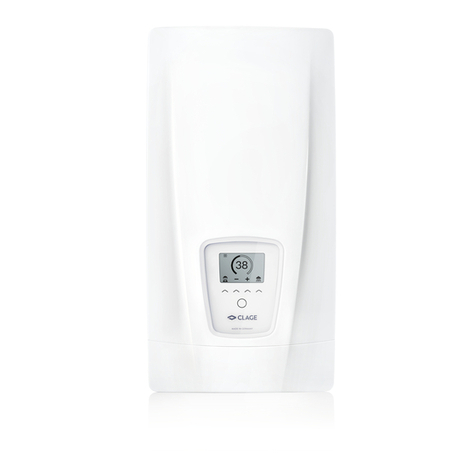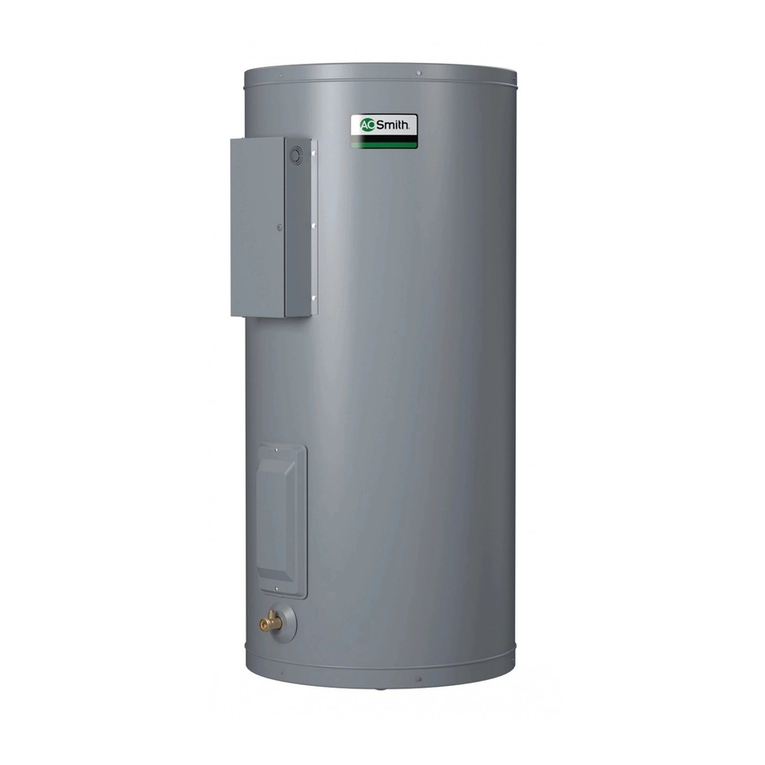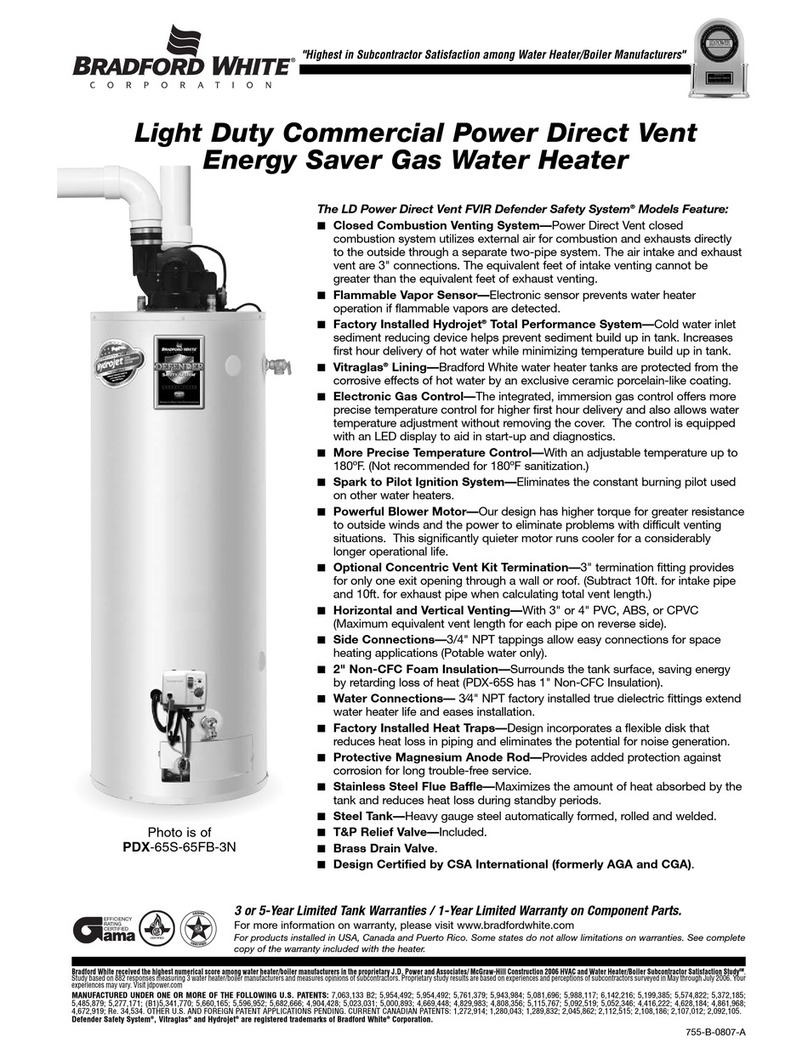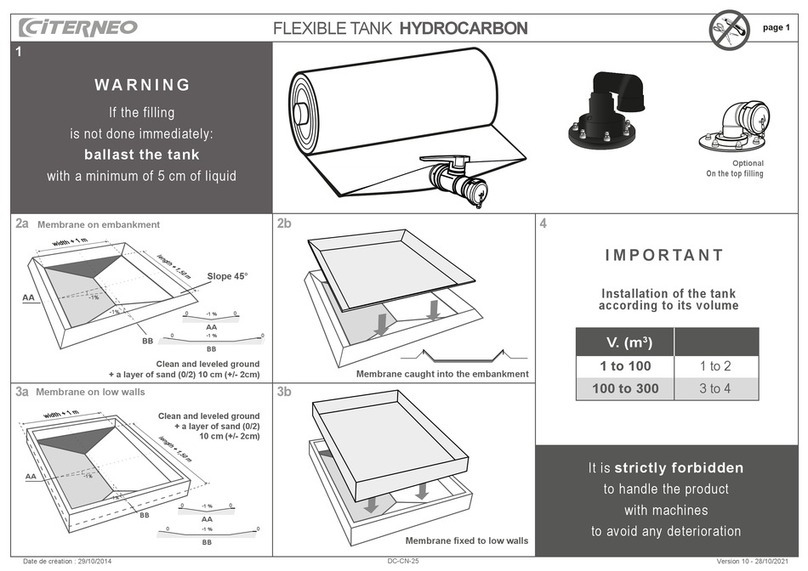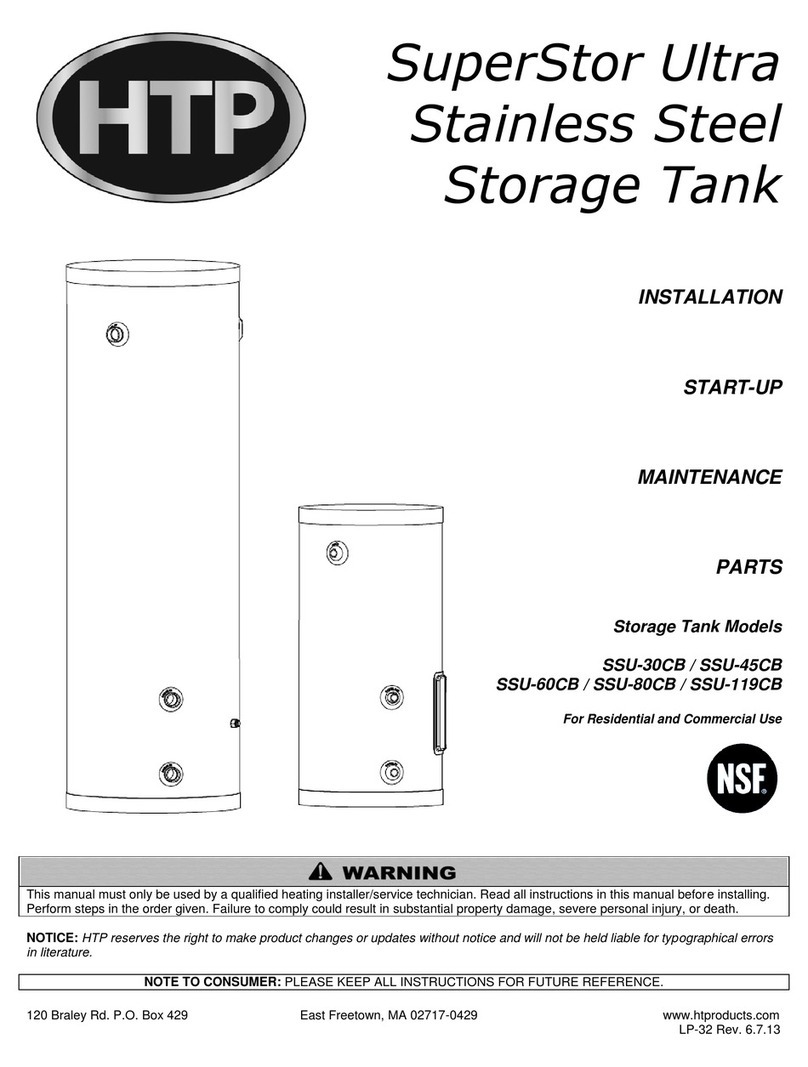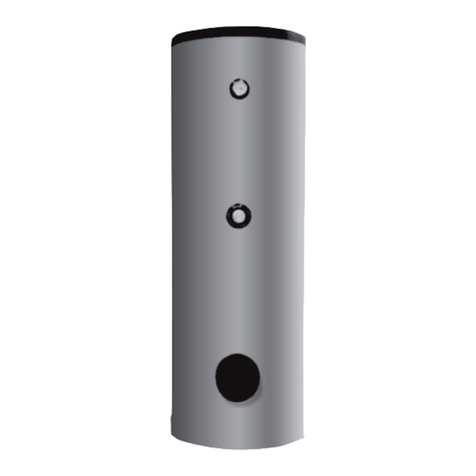Polymaster ST3100 Installation guide

Septic Tank
1. Select site
• Contact relevant authorities
before digging to locate all
underground cables and pipes
• Determinethe best location of the
tank taking into account existing
underground services, excavation
required, locationof blackwater run and
heights into tank and outlet fall to drain.
• Is the tank excavationhole far enough
away not to impact on foundations
and adjoining structures? Where
no regulations exist the distance of
the excavationfrom any structure
should beaminimum of 2times
thedepth of the excavation.
• Consult with a Geotechnical Engineer
if you have any questions about
possibleinfluence of excavation
on surrounding structures
• Must not be installed where there is
apossibility of water table exceeding
half the height of the tank
2. Excavation
• Excavate hole according to
dimensions of tank
• Excavationslopes should be a
minimum of 30 degrees
• Hole depth should bea minimum of 1675
below finished pavement /lawn level
• Remove all loose soil from baseof hole,
and add 100mm of sand or crusher
dust and compact to a firm level pad.
• Be aware of thesafe working practice
for working in excavated holes.
• Hole dimensions at the base should
be a minimum of 200mm larger in
width and length of thetank.
Installation Guide
• ST3100
• ST4550
CHECKFIRST...
Read this manual thoroughly to ensure
all procedures are understood and
materials needed are available.
1800 062 064
polymaster.com.au
Innovative products
engineered with confidence

3. Positioning Tank
• Using the top lifting points for
stability, lift tank into place by use
of a backhoe or excavator.
• The Tank has 4 feet for stability but
extra chocking may be necessary
depending on conditions
• Using the access hole for a guide,
level tank in both directions
4. Backfilling
• Before commencing backfill, fill the tank
with water up to the half way mark.
• The backfill material around the tank
must be compacted inlayers not
exceeding 200mm.Use only hand
held vibrating plate compactors
in the compaction process.
• Use cohesionless material such as
sand, crusher dust, 6mm FCR etc. as a
as shown. The material should be a
minimum density of 18KN/m3 and
maximum density of 20KN/m3.
5. Final hookup
• Ensure all caps and overflows are sealed
prior to backfilling the excavation
and check all connections.
• Apply 20mm silicone bead around the
groovein the top of theaccess hole
and fasten lid down with tek screws.
• If ariser is to be used, fasten riser
in from the inside with silicone
and tek screws and thenfit lid.
HEALTH & SAFETY
taken to ensure the customer ’s health and safety. The following points need to be carefully considered:
• Useaqualified plumber/installer to install and fit-up tank.
• When lifting tank in to place use the appropriate lifting lugs onthe tank and lower evenly into
hole. Do not manhandletank in to place or try lifting manually as injury could occur.
• young children, personnel and animals, and could result in death by drowning.
• All Worksafe regulations and safe work procedures should be adhered to when
installing your septic tank. Never enter the tank at any timewithout adhering to all
guidelines and protocols of relevant confined space entry warnings and directions.
IMPORTANT
It is the responsibility of the owner to ensure proper installationand maintenance of the
underground tank. Polymaster will not beheld responsible for any loss, injury or death resulting
from a failure to observe all safety and installation requirements or safe working procedures.
PAGE 2 – Polymaster Septic TankInstallation Guide
100mm Sand
bedding layer
Indicative
excavation
line
Compact
in layers of
200mm.
Use free draining
granular material
Max density 20kN/m3
Min density 18kN/m3
of backfill
Finished pavement/lawn level

Care of your Septic system
Owners reference
Polymaster septic systems
Septic systems are ‘on site’ individual wastewater
systems that usethe soil to absorb and
naturally treat wastewater flows. They are
typically used where centralised sewerage
treatment is impractical or not available.
Aseptic system uses bacteria to break
down the waste and therefore it is important
that you do not usecleaning products
or dispose of any product down the
drainage system that will kill bacteria.
Items to watch out for are:
• Products that contain chlorine
or ammonia
• Fats and greases
• Non-degradables suchas
disposable nappies,sanitary
napkins,cat litter, plastics etc.
• Poisons like petrol,paint,
thinners, pesticides etc.
• Excessive food scraps
There is a range of biological cleaning
products that are madespecifically
for usewith septictank systems.
Odours
It is normal in thefirst few weeks of operation for
yourseptic tank to produce someodours which
after ashort time will disappearor be replaced
with a slight earthy smell. If there is much change
to your situation you may find you have used some
chemicals or have put a large amount of washing
through the laundry. If this is the case theunit will
correct itself in a few days; try to spread the
laundry evenly over the weekas much as possible.
Ground Maintenance
Septic systems have a network of drainage
pipes that allows the wastewater to seep into
the subsurface soil. The area over this ‘drainfield’
should beleft undisturbed with only amowed
grass cover. Divert excessive ground/stormwater
away from this area and be aware that roots from
nearby trees orshrubs may clog and damage
your drain lines. Do not allow anyone to drive
or park over any part of the drainage system.
Remember: less water used means less
water to be treated and disposed of.
Desludging your septic tank
Septic systems overtime will build up withan
excess of accumulated solids that should be
pumped out every 3-5 years. This depends
a lot on the volume that is put through the
tank so varies greatly on applications.
Make sure the tank is pumped out
by alicensed liquid waste contractor,
pleasesee the local council in your area
about any special EPA regulations.
in the tank to ensure tank does not
float up or become dislodged.Bacteria
levels in the tankwill restore once
wastewater enters the system again.
For more information about maintenance
or inspection of your Polymaster Septic
System contact the plumberwho
installed your tank or the local council.
Please Note: Never allow anyone at any time to enter the septic tank as it is
a confined space and once operating is an extreme health risk.
PAGE 3 – Polymaster Septic Tank Installation Guide

ACKNOWLEDGMENTANDRELEASE
The customer undertakes to install our underground tanks strictly to the manufacturer’s directions, recommendations and specifications
as contained in the Installation Manual accompanying the tank.
of thesetanks,the customeragrees that he/sheshall not hold the manufacturer (Polymaster) liable and acknowledges and accepts that
the customeris wholly liable for such loss and damage and releases the manufacturer from any liability.
Thank you
Thank you for purchasing a Polymaster Septic Tank. The purpose of a septictank is to
provide a complete septic tank system which complies to Australian Standards, and
gives you guaranteed performance.
Stringent testing
Some of the stringent testing and standards we have complied to are listed below:
• Complies with AS/NZS1546.1:2008 for the constructionof septic tanks.
• Tanks have been designed using engineering design
methods including finite element analysis.
• By following the installation requirements. You will find this
tank will give you many years of troublefree service.
Warranty details
Polymaster septic tanks come with aseven year manufacturer’s warranty. This is to keep
meets with accreditation guidelines guaranteeing aservice life of 15 years.
To validate your warranty all installationinstructions must be strictly adhered to. When
outlined below.
Please visit warranty.polymaster.com.au to submit
your warranty on this product.
•Alternatively, if you do not have access to the online
warranty page, contact us on 1800 062 064
•Please activate your warranty online at
warranty.polymaster.com.au
Activate your warranty
Like us on
Enter Our ‘my tank’ Photo Competition
Coles Group & Myer Gift Card
$100
We would love to hear about your experience with Polymaster...
Please share your comments on our facebook page!
facebook.com/polymastergroupaust
to WIN a $100 Coles Myer Gift Card! Drawn monthly.
2 Ways to Enter :
Post a photo of your new tank/s on Facebook.
Type ‘ @Polymaster Group ’ (select our page)
1.
•Alternatively, if you do not have access to the online
warranty page, contact us on 1800 062 064
•Please activate your warranty online at
warranty.polymaster.com.au
Activate your warranty
Like us on
Enter Our ‘my tank’ Photo Competition
Coles Group & Myer Gift Card
$100
We would love to hear about your experience with Polymaster...
Please share your comments on our facebook page!
facebook.com/polymastergroupaust
to WIN a $100 Coles Myer Gift Card! Drawn monthly.
2 Ways to Enter :
Post a photo of your new tank/s on Facebook.
Type ‘ @Polymaster Group ’ (select our page)
and hashtag #mypolymastertank
1.
We would love to hearabout your experience with Polymaster...
Please share your comments on our facebook page!
facebook.com/polymastergroupaust
1800062064 | polymaster.com.au
This manual suits for next models
1
Popular Water Heater manuals by other brands
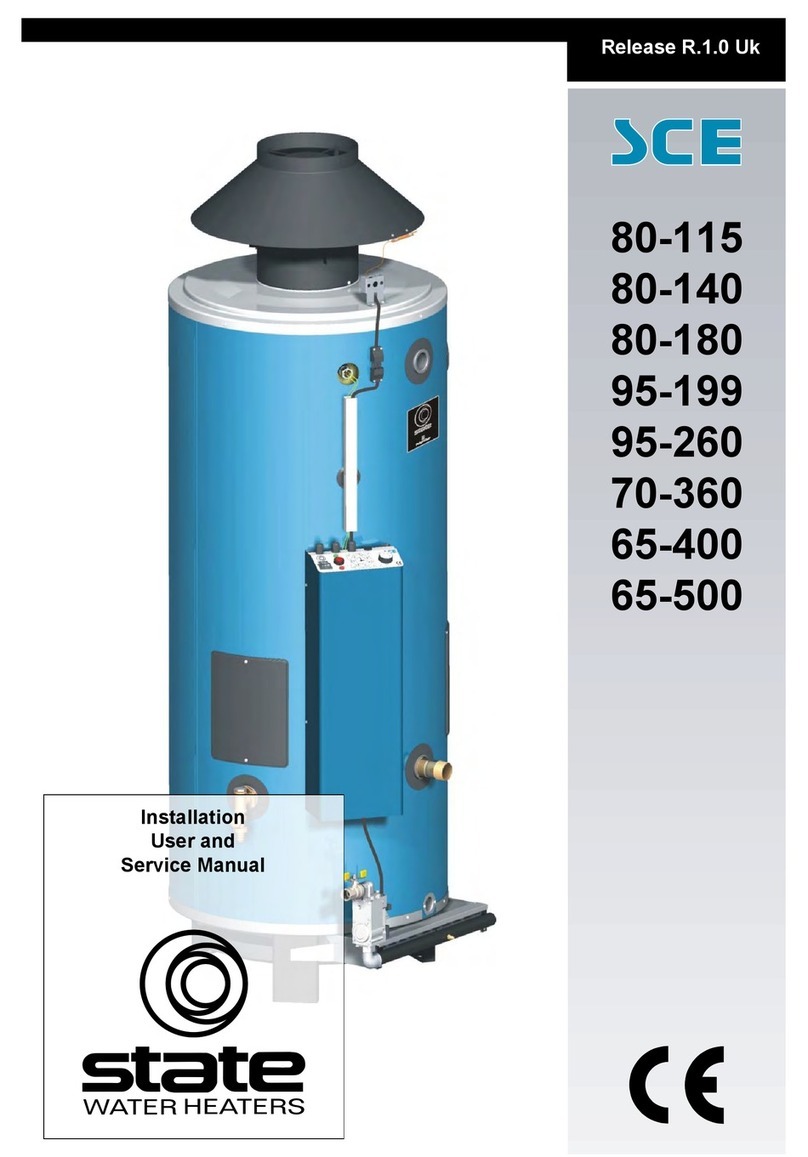
State Water Heaters
State Water Heaters SCE 80-115 Installation, user and service manual

A.O. Smith
A.O. Smith BTH 120 - 250 Installation & operation instruction
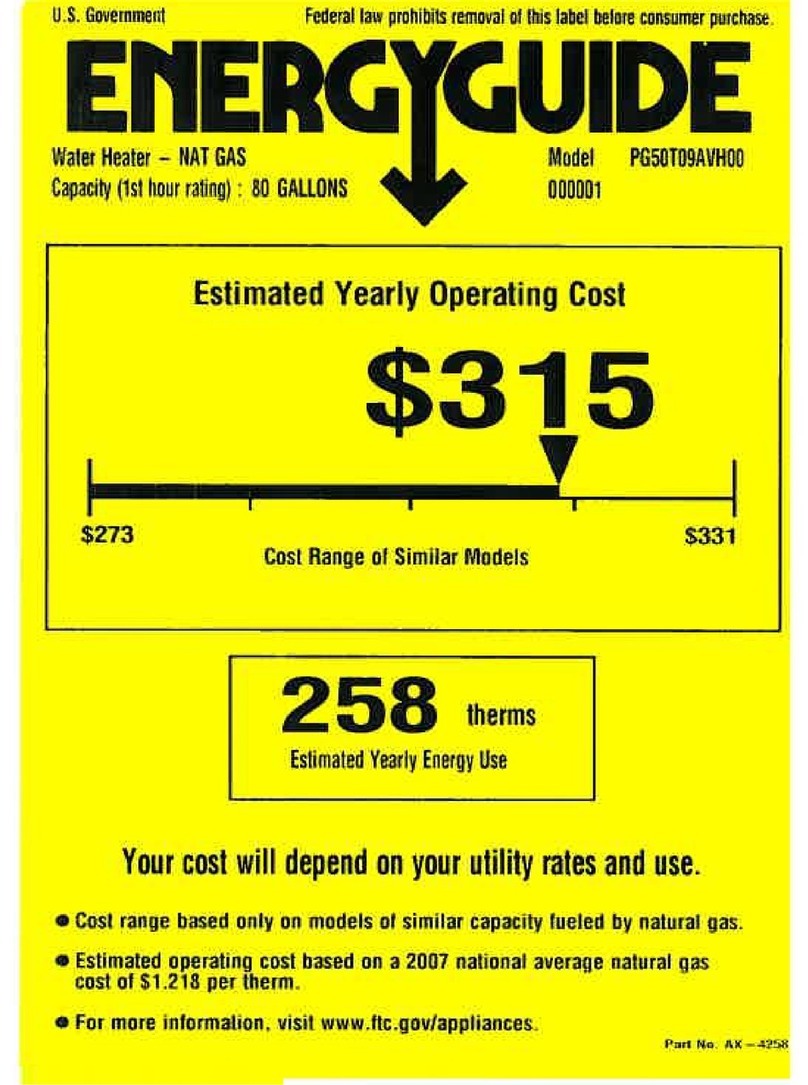
GE
GE PG50T09AVH Energy guide
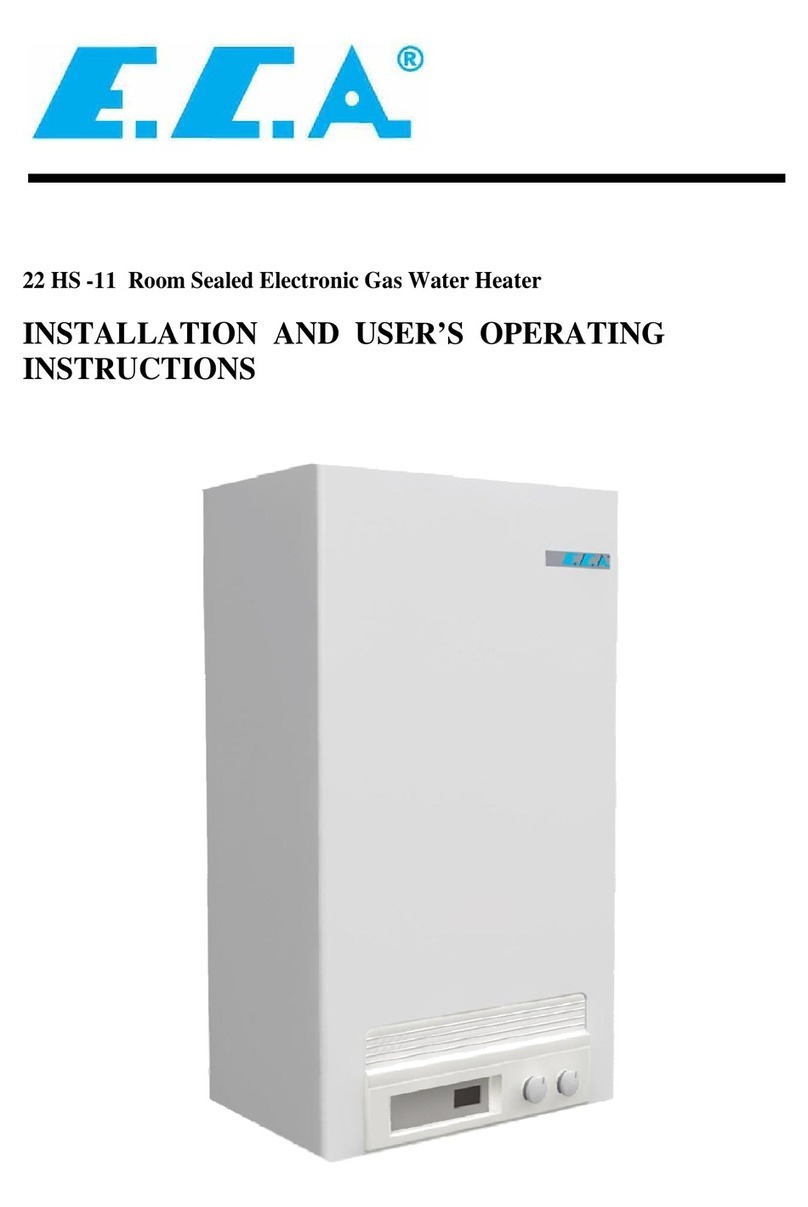
E.C.A.
E.C.A. 22 HS -11 Installation and user's operating instructions
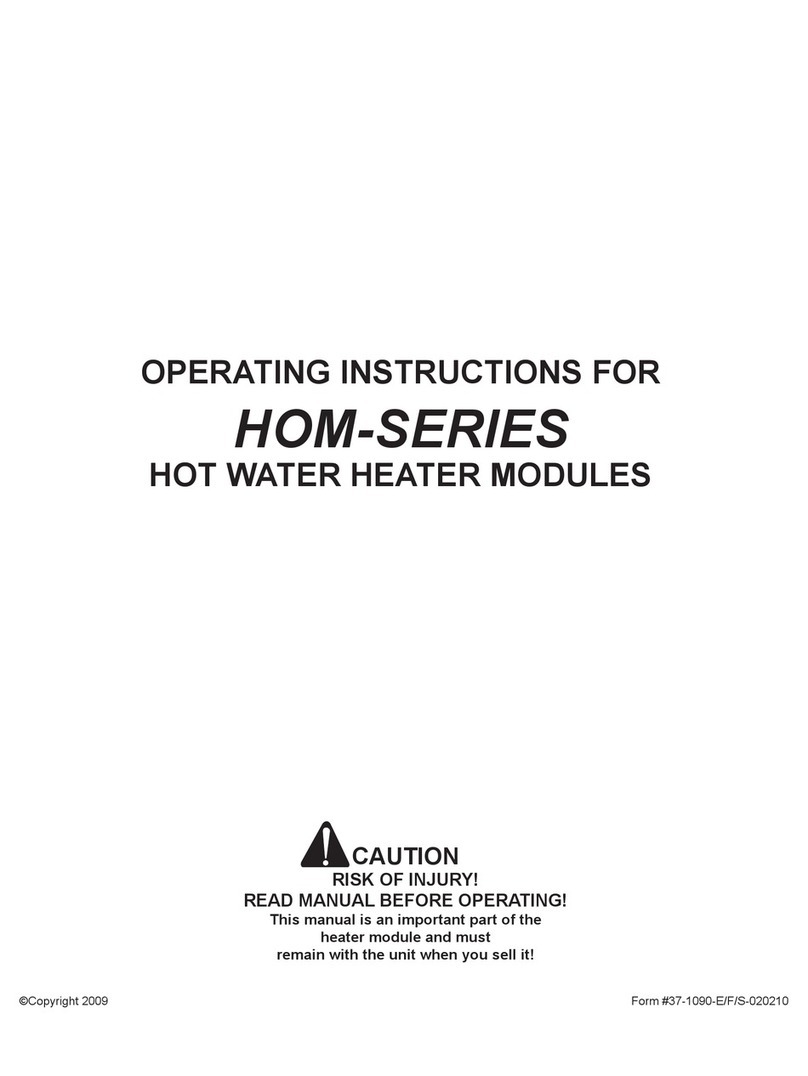
Mi-T-M
Mi-T-M HOM-SERIES operating instructions
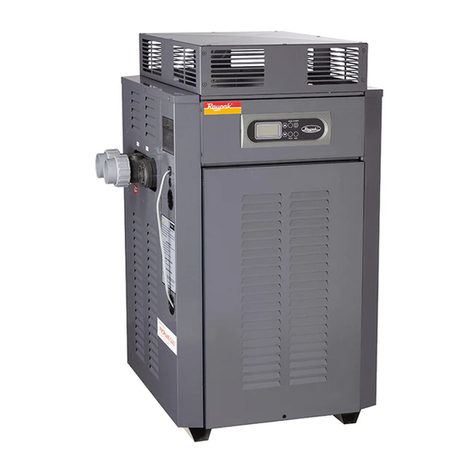
Raypak
Raypak B0200 owner's guide

Nibe
Nibe AP-WH7 operating manual

Giant
Giant UG30-32MF1-C2U owner's manual

Rheem
Rheem 60 Gallon Use & care manual

flowair
flowair LEO FL 30 Technical documentation operation manual
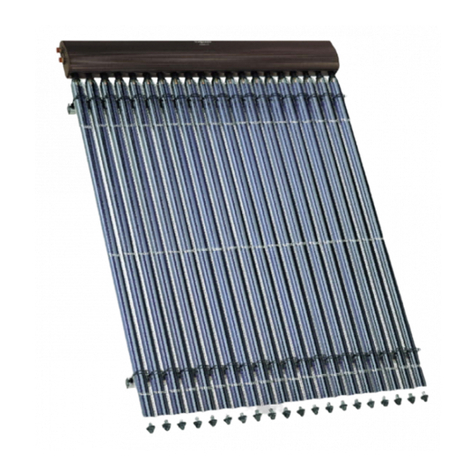
Viessmann
Viessmann Vitosol 100 Start up & operation manual
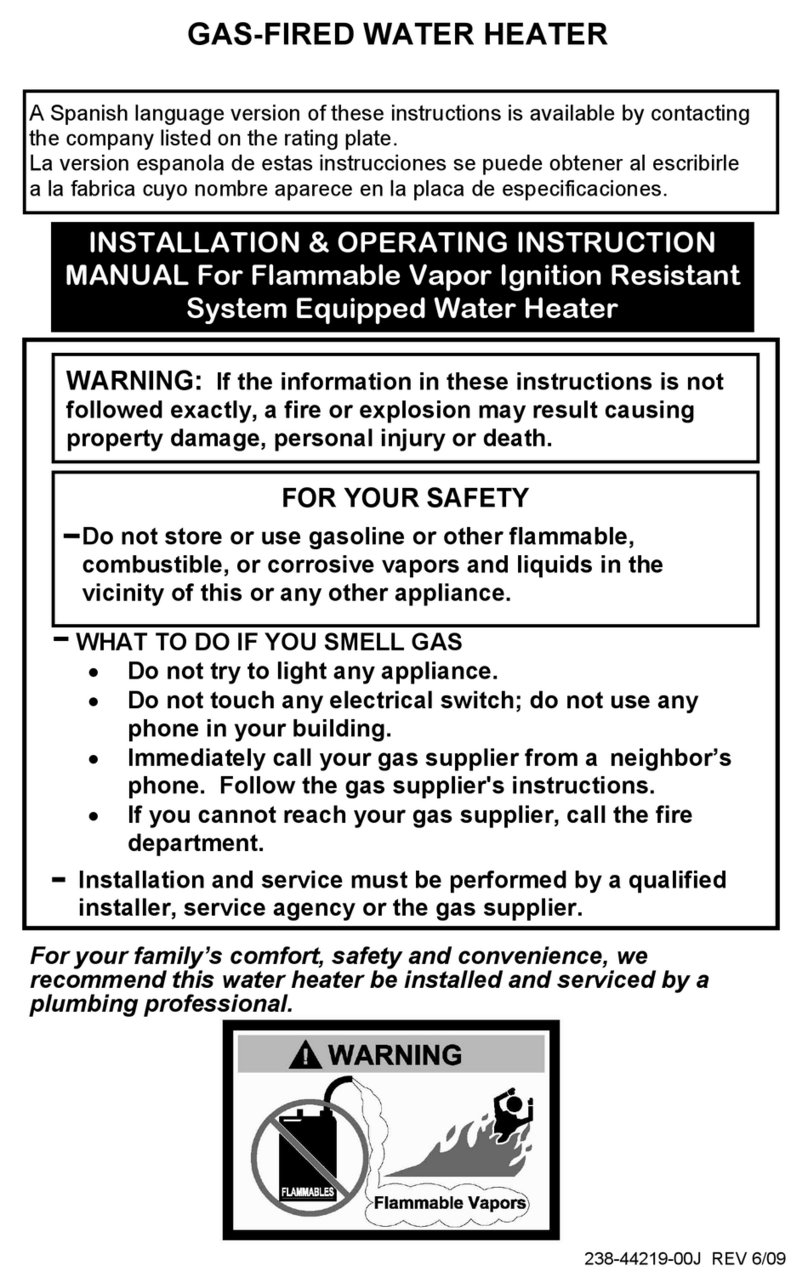
Bradford White
Bradford White 238-44219-00J Installation and operating instruction manual
